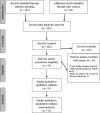Impact of Valve Morphology on the Prevalence of Coronary Artery Disease: A Systematic Review and Meta-Analysis
- PMID: 27194004
- PMCID: PMC4889190
- DOI: 10.1161/JAHA.116.003200
Impact of Valve Morphology on the Prevalence of Coronary Artery Disease: A Systematic Review and Meta-Analysis
Abstract
Background: Literature studies suggested a lower prevalence of coronary artery disease (CAD) in bicuspid aortic valve (BAV) than in tricuspid aortic valve (TAV) patients. However, this finding has been challenged. We performed a meta-analysis to assess whether aortic valve morphology has a different association with CAD, concomitant coronary artery bypass grafting (CABG), and postoperative mortality.
Methods and results: Detailed search was conducted according to the PRISMA (Preferred Reporting Items for Systematic reviews and Meta-Analyses) guideline to identify all patients with BAV or TAV and presence of CAD, concomitant myocardial surgical revascularization, and the postoperative mortality. Thirty-one studies on 3017 BAV and 4586 TAV patients undergoing aortic valve surgery were included. BAV patients showed a lower prevalence of CAD (odds ratio [OR]: 0.33; 95% CI: 0.17, 0.65), concomitant CABG (OR, 0.45; 95% CI: 0.35, 0.59), and postoperative mortality (OR, 0.62; 95% CI: 0.40, 0.97) than TAV. However, BAV subjects were significantly younger than TAV (mean difference: -7.29; 95% CI: -11.17, -3.41) were more frequently males (OR, 1.61; 95% CI: 1.33, 1.94) and exhibited a lower prevalence of hypertension (OR, 0.58; 95% CI: 0.39, 0.87) and diabetes (OR, 0.71; 95% CI: 0.54, 0.93). Interestingly, a metaregression analysis showed that younger age and lower prevalence of diabetes were associated with lower prevalence of CAD (Z value: -3.03; P=0.002 and Z value: -3.10; P=0.002, respectively) and CABG (Z value: -2.69; P=0.007 and Z value: -3.36; P=0.001, respectively) documented in BAV patients.
Conclusions: Analysis of raw data suggested an association of aortic valve morphology with prevalence of CAD, concomitant CABG, and postoperative mortality. Interestingly, the differences in age and diabetes have a profound impact on prevalence of CAD between BAV and TAV. In conclusion, our meta-analysis suggests that the presence of CAD is independent of aortic valve morphology.
Keywords: aortic valve morphology; bicuspid aortic valve; coronary artery disease.
© 2016 The Authors. Published on behalf of the American Heart Association, Inc., by Wiley Blackwell.
Figures






Similar articles
-
Outcomes of valve-sparing aortic root replacement in patients with bicuspid aortic valve and tricuspid aortic valve: a systematic review and meta-analysis.J Cardiothorac Surg. 2023 Jul 3;18(1):206. doi: 10.1186/s13019-023-02329-8. J Cardiothorac Surg. 2023. PMID: 37400892 Free PMC article.
-
Comparing outcomes after transcatheter aortic valve replacement in patients with stenotic bicuspid and tricuspid aortic valve: A systematic review and meta-analysis.Clin Cardiol. 2018 Jul;41(7):896-902. doi: 10.1002/clc.22992. Epub 2018 Jul 18. Clin Cardiol. 2018. PMID: 29896777 Free PMC article.
-
Heritability of aortic valve stenosis and bicuspid enrichment in families with aortic valve stenosis.Int J Cardiol. 2022 Jul 15;359:91-98. doi: 10.1016/j.ijcard.2022.04.022. Epub 2022 Apr 13. Int J Cardiol. 2022. PMID: 35427703
-
Surgical thresholds for bicuspid aortic valve associated aortopathy.JACC Cardiovasc Imaging. 2013 Dec;6(12):1311-20. doi: 10.1016/j.jcmg.2013.10.005. JACC Cardiovasc Imaging. 2013. PMID: 24332283
-
Effect of Bicuspid or Tricuspid Aortic Valve on Preoperative Coagulation in Patients Scheduled for Thoracic Aortic Surgery.J Cardiothorac Vasc Anesth. 2025 Aug;39(8):2040-2048. doi: 10.1053/j.jvca.2025.04.029. Epub 2025 Apr 22. J Cardiothorac Vasc Anesth. 2025. PMID: 40379491
Cited by
-
Substantial Cardiovascular Morbidity in Adults With Lower-Complexity Congenital Heart Disease.Circulation. 2019 Apr 16;139(16):1889-1899. doi: 10.1161/CIRCULATIONAHA.118.037064. Circulation. 2019. PMID: 30813762 Free PMC article.
-
Extent of Coronary Artery Disease in Patients With Stenotic Bicuspid Versus Tricuspid Aortic Valves.J Am Heart Assoc. 2021 Jun 15;10(12):e020080. doi: 10.1161/JAHA.120.020080. Epub 2021 Jun 2. J Am Heart Assoc. 2021. PMID: 34075785 Free PMC article.
-
Differences at surgery between patients with bicuspid and tricuspid aortic valves.Neth Heart J. 2019 Feb;27(2):93-99. doi: 10.1007/s12471-018-1214-1. Neth Heart J. 2019. PMID: 30547414 Free PMC article.
-
The Prevalence of Coronary Artery Disease in Bicuspid Aortic Valve Patients: An Overview of the Literature.Aorta (Stamford). 2023 Dec;11(6):191-197. doi: 10.1055/s-0044-1785190. Epub 2024 May 2. Aorta (Stamford). 2023. PMID: 38698623 Free PMC article.
-
Coronary Artery Disease and Severe Aortic Stenosis: Contemporary Treatment Options for Patients Undergoing Transcatheter Aortic Valve Implantation.J Clin Med. 2024 Dec 14;13(24):7625. doi: 10.3390/jcm13247625. J Clin Med. 2024. PMID: 39768548 Free PMC article. Review.
References
-
- Nkomo VT, Gardin JM, Skelton TN, Gottdiener JS, Scott CG, Enriquez‐Sarano M. Burden of valvular heart diseases: a population‐based study. Lancet. 2006;368:1005–1011. - PubMed
-
- Osnabrugge RL, Mylotte D, Head SJ, Van Mieghem NM, Nkomo VT, LeReun CM, Bogers AJ, Piazza N, Kappetein AP. Aortic stenosis in the elderly: disease prevalence and number of candidates for transcatheter aortic valve replacement: a meta‐analysis and modeling study. J Am Coll Cardiol. 2013;62:1002–1012. - PubMed
-
- Pawade TA, Newby DE, Dweck MR. Calcification in aortic stenosis: the skeleton key. J Am Coll Cardiol. 2015;66:561–577. - PubMed
-
- Stewart BF, Siscovick D, Lind BK, Gardin JM, Gottdiener JS, Smith VE, Kitzman DW, Otto CM. Clinical factors associated with calcific aortic valve disease. Cardiovascular Health Study. J Am Coll Cardiol. 1997;29:630–634. - PubMed
-
- Patel DK, Green KD, Fudim M, Harrell FE, Wang TJ, Robbins MA. Racial differences in the prevalence of severe aortic stenosis. J Am Heart Assoc. 2014;3:e000879 doi: 10.1161/JAHA.114.000879. - DOI - PMC - PubMed
Publication types
MeSH terms
LinkOut - more resources
Full Text Sources
Other Literature Sources
Medical
Miscellaneous

